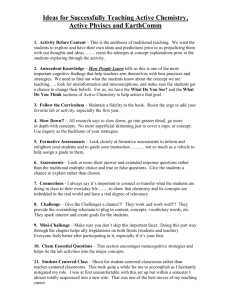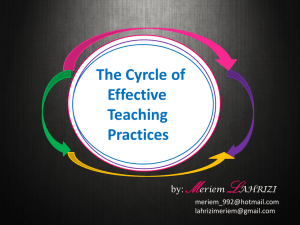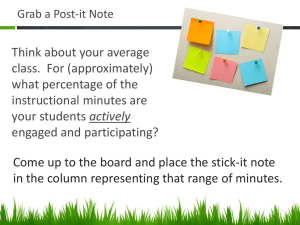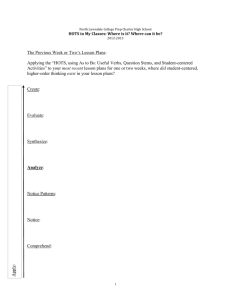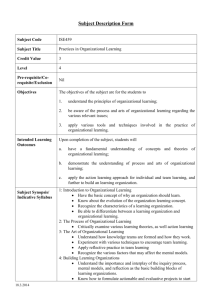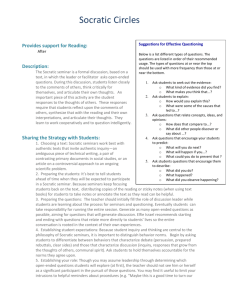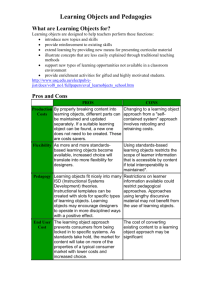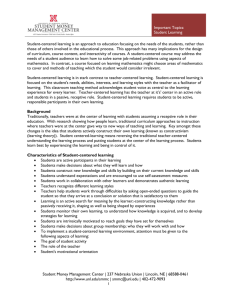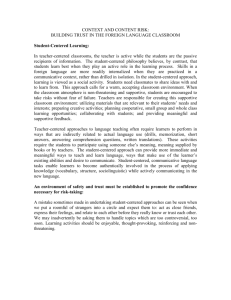7.Journal-of-Management Education-2009-Foster-676
advertisement
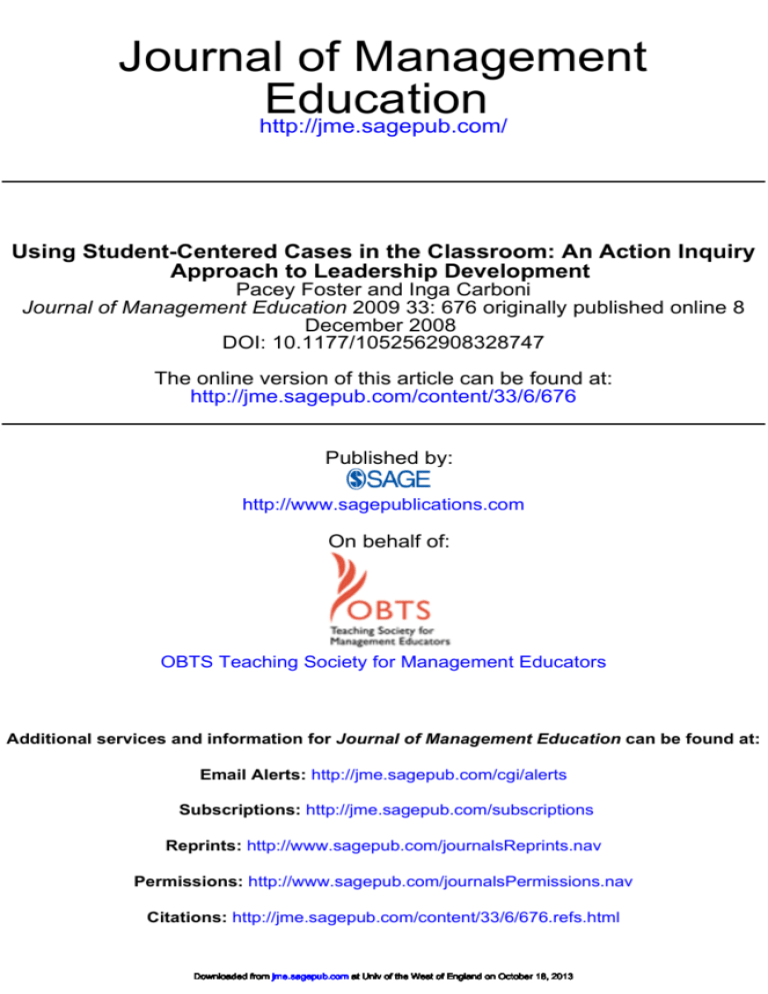
Journal of Management Education http://jme.sagepub.com/ Using Student-Centered Cases in the Classroom: An Action Inquiry Approach to Leadership Development Pacey Foster and Inga Carboni Journal of Management Education 2009 33: 676 originally published online 8 December 2008 DOI: 10.1177/1052562908328747 The online version of this article can be found at: http://jme.sagepub.com/content/33/6/676 Published by: http://www.sagepublications.com On behalf of: OBTS Teaching Society for Management Educators Additional services and information for Journal of Management Education can be found at: Email Alerts: http://jme.sagepub.com/cgi/alerts Subscriptions: http://jme.sagepub.com/subscriptions Reprints: http://www.sagepub.com/journalsReprints.nav Permissions: http://www.sagepub.com/journalsPermissions.nav Citations: http://jme.sagepub.com/content/33/6/676.refs.html Downloaded from jme.sagepub.com at Univ of the West of England on October 18, 2013 >> Version of Record - Nov 2, 2009 OnlineFirst Version of Record - Dec 8, 2008 What is This? Downloaded from jme.sagepub.com at Univ of the West of England on October 18, 2013 Using Student-Centered Cases in the Classroom Journal of Management Education Volume 33 Number 6 December 2009 676-698 © 2009 The Author(s) 10.1177/1052562908328747 http://jme.sagepub.com An Action Inquiry Approach to Leadership Development Pacey Foster University of Massachusetts Inga Carboni Mason School of Business This article addresses the concern that business schools are not adequately developing the practical leadership skills that are required in the real world of management. The article begins by discussing the limitations of traditional case methods for teaching behavioral skills. This approach is contrasted with an alternative case method drawn from action inquiry (AI) that uses ongoing student cases to develop more effective leadership behaviors. The studentcentered case approach is distinguished from traditional case teaching by tracing an important similarity between AI and Socratic pedagogy. A leadership workshop for evening MBAs that uses AI pedagogy to help students improve their leadership behaviors at work and in the class is also described. The article concludes with a discussion of the significant benefits and challenges associated with helping students develop new leadership behaviors. Keywords: case method; student cases; action science; action inquiry; leadership development R ecent articles in the academic and popular press raise persistent questions about whether business schools are providing adequate training in the real world practice of management (Pfeffer & Fong, 2002; Rynes, Authors’ Note: The authors gratefully acknowledge the contributions of Bill Torbert and the many other colleagues who provided the theoretical frameworks that we use in our courses and in this article. We also appreciate the feedback we received from Fulton 214 (Erica Foldy, Danna Greenberg, Tammy MacLean, Peter Rivard, and Steve Taylor) who gave us important input on early drafts of this manuscript. Finally, we are grateful for the close reading and helpful suggestions provided by Bill Ferris and the anonymous reviewers who helped us make this a better article. Address correspondence to Pacey Foster, University of Massachusetts Boston, College of Management, 100 Morrissey Boulevard, Boston, MA 02125-3393; e-mail: pacey.foster@umb.edu. 676 Foster, Carboni / Using Student-Centered Cases in the Classroom 677 Trank, Lawson, & Ilies, 2003). Critics argue that business schools focus on technical skills and analysis at the expense of developing effective practice (Mintzberg & Gosling, 2002; Pfeffer & Fong, 2002). Even the behavioral courses that are specifically designed to teach management skills seem unrelated to the actual conduct of business to our students and their recruiters (Latham & Latham, 2000; Rynes & Trank, 1999; Rynes et al., 2003). Despite numerous studies and writings on the importance of experiential, work-based and problem-based learning (Kolb, 1984; Peterson, 2004; Raelin, 2000; Whetton & Cameron, 2007), integrating skill-specific practice with real world student experiences presents an ongoing challenge in management education. Using real-world business cases was one of the first responses to the problem of linking course content to the practice of management. Case teaching is often touted as an example of experiential problem-based learning (see Corey, 1996). Business cases were originally intended to help students hone their problem-solving skills by presenting them with a “real world” business issue and then using Socratic-style questioning to sharpen their understanding of the issue and ways to address it (Dewing, 1931). The typical approach to the case method, however, often has the unintended effect of encouraging students to perceive problem solving as the ability to properly apply abstract theories to diagnose relatively tidy situations, a skill that is unlikely to help them when they confront the real people and events that populate the messy, uncertain, ambiguous, and ever-changing dynamics of the typical organization (Cohen, 1989). Critics have pointed out that cases are often used to lead students through a well-practiced analysis to a predetermined set of conclusions through the use of artful rhetorical devices (Argyris, 1980; Cohen, 1989; Mintzberg, 2006; Mintzberg & Lampel, 2001; Shugan, 2006). For example, Grenier, Bhambri, and Cummings (2003) found that “today’s case teaching approach appears to be heavily deductive, with instructors guiding students, sometimes unintentionally, to ‘answers’ that confirm the validity of concepts being taught” (p. 405). Furthermore, as Cohen (1989) notes, this approach to the case method not only reinforces student passivity but also implicitly “teaches that good leadership is maneuvering others into saying what you wanted them to say while getting them to believe they came up with the answer!” (p. 73). Students learn how to apply theory but may fall short of developing actionable leadership skills. Concerns about the limitations of case teaching are part of a larger effort to move management education from a teaching-centered to a learning- centered endeavor in which students generate, rather than simply receive, 678 Journal of Management Education knowledge (Barr & Tagg, 1995). This insight has been at the heart of the management skills movement which integrates case teaching with skillspecific exercises, reflective writing, role plays, and other methods designed to help students apply management theories to practice (Bigelow, 1991; Bigelow et al., 1999; Whetten & Cameron, 1983, 2007). Although this movement has successfully integrated skills practice into many management curricula, even some of these efforts have been criticized for focusing too much on developing specific skills rather than on developing a deeper sense of “skillfulness” that can guide action in new and unexpected situations (Bigelow, 1995). In this article, we offer a novel approach to case teaching that grows out of action inquiry (AI) pedagogy (Torbert & Associates, 2004). Because this approach uses ongoing student-centered cases to link inductive experience with deductive theorizing, it also provides a response to early calls from management skills educators that we include more inductive learning in management skills teaching (Bigelow, 1995). In this respect, our pedagogy is also congruent with theories that treat leadership as a state of being in the world as much as a set of predefined skills to be practiced (e.g., Quinn, 2004). We begin by contrasting this approach and the traditional approach to teaching management cases. We argue that student-centered cases resurrect an important and hitherto neglected aspect of traditional Socratic pedagogy. We then give a detailed description of a leadership workshop for evening MBAs that integrates student-centered cases with other AI techniques to help students improve their leadership behaviors at work and in the class. Action Inquiry: A Student-Centered Case Method Business cases can be a useful way to demonstrate how management theories can help analytically disentangle the causes of complex business phenomena and provide general recommendations. They can also be powerful and memorable illustrations of common business problems and canonical theories. But cases are ill-suited for developing new behaviors— even when paired with role plays and other simulation techniques. No matter how artfully they are used (Greenhalgh, 2007), cases tend to focus on the application of previously learned ways of thinking to new situations (Argyris, 1980). They rarely support the development of new ways of thinking or, more important, new leadership behaviors. Part of the problem may be in the way the traditional Socratic techniques have been modified to teach cases. Foster, Carboni / Using Student-Centered Cases in the Classroom 679 Case teaching methods (see Barnes, Christensen, & Hansen, 1994) clearly employ the didactic questioning style of the Socratic dialogs but may overlook the deeper purpose of such cross-examination. The primary goal of Socratic questioning was not to lead students to predefined answers (as modern practitioners of case methods sometimes do). Rather, Socrates used elenchus (meaning to examine or refute) to perplex his students and remove the “false conceit of thinking one knows when one does not” (Seeskin, 1987, p. 100). Through the careful use of cross-examination, Socrates forced his students to face the inherent contradictions between their most deeply held beliefs and actions. A critical aspect of this method was the recognition that students might not be aware of the theories and beliefs that are guiding their actions and may even hold beliefs that contradict each other or their actions. The role of the Socratic instructor is therefore not only to help students infer general rules from specific cases but also to help students identify the logical arguments that connect their very own beliefs and actions. By combining elenchus with dialectic, Socrates forced his students to confront the limitations of their existing mental models and facilitated genuine inquiry among his students. This gave them the option to generate more effective mental ­ odels which then could lead them to taking more effective action. m Socrates’s stance as a cogenerator of knowledge was thus modeled for and developed in his students who learned to practice it on themselves and with each other. The first requirement of practicing elenchus is to “say what you believe” and, by doing so, to reinforce the Socratic preference for personal congruence over feigned certitude (Vlastos, 1985, p. 4). In short, the value of this approach was not so much in the philosophical truths that Socrates helped “birth” but the skill of seeking out and confronting discrepancies between thoughts and actions that he helped his students develop. That this process could be uncomfortable—even painful—is exactly what made it useful to master. Socrates’s search for congruence between words and actions (i.e., between “truths” that are espoused and “truths” that are acted on) is central to his enduring reputation as a transformational educator. Modern case methods, which rely on descriptions of actions taken (or to be taken) by other people whose thought processes are only sketchily revealed at best, do not lend themselves to producing the contradictions of elenchus. For this reason and many others, case methods alone are not sufficient for developing actionable knowledge. Simulations and role playing games are much better, but still lack the sharpness of a hook that has real world implications for students. The fields of action inquiry (Torbert, 1991; 680 Journal of Management Education Torbert & Associates, 2004) and action science (Argyris, 1982; Argyris, Putnam, & Smith, 1985) share a long tradition of using personal cases as the foundation for developing more effective behaviors and serve as the pedagogical foundation of our course. The fundamental insight of these theories is that dysfunction in human systems is typically caused by unconscious cognitive routines that generate untested (and often inaccurate) conclusions about means–ends relationships in the social world. To develop more effective ways of acting, a person (or group) must identify the negative impacts of currently held cognitive routines. This theory also contains a general typology for identifying more and less effective cognitive routines—thereby helping students learn ­behavioral heuristics to be practiced in increasingly challenging personal experiments. Argyris et al. and Torbert (Argyris, 1982; Argyris et al., 1985; Torbert, 1972) noted that many dysfunctional group dynamics can be described by a set of cognitive routines (e.g., schemas and scripts) originally called Model I and eventually renamed Mystery-Mastery (MM). This label refers to the prescription of keeping one’s concerns and feelings and thoughts a mystery (to self and others) while maximizing unilateral mastery of the social world. MM routines support predetermined outcomes and leave little room for publicly testing the suitability of the outcomes themselves or the logic that generated them. According to these theories, MM routines are a frequent, if unrecognized, source of social conflict and undesirable outcomes (Argyris, 1982; Torbert, 1972). These authors also identified a more effective though rarely practiced cognitive routine that was originally called Model II and was subsequently renamed Collaborative Inquiry. This set of heuristics closely resembles the Socratic approach in that it recognizes the importance of publicly testing the congruence between the stated and enacted goals of individuals, group, and the organizations of which they are a part. Consistent with Socratic pedagogy, the first goal of an educator is therefore to confront students with the limitations of their existing ways of thinking or, mental models, as they are applied in actions taken in the real world. Recognizing and dialectically discussing gaps between mental models and outcomes is a central part of this process. An important tool in action inquiry and action science is the use of personal cases to explore the negative impact of existing individual and group level cognitive routines on a current problem (Argyris et al., 1985; Torbert & Associates, 2004). Personal cases and collaborative reflection techniques help people systematically examine the links between their mental models Foster, Carboni / Using Student-Centered Cases in the Classroom 681 and behaviors. One powerful technique uses “two-column” cases as the raw material for collaborative off-line reflection sessions (Rudolph, Taylor, & Foldy, 2001; Senge, Kleiner, Roberts, Ross, & Smith, 1994). In this case method, individuals are first asked to privately reflect on a recent conversation that did not turn out as they had hoped and reconstruct the dialog in the right-hand column of a two-column sheet of paper. Next, the case writer rereads the dialog and reconstructs the thoughts and feelings that were going on at the time. In small groups, individuals share these personal cases and the group helps each case writer to systematically examine the sloweddown conversation to identify discrepancies between thoughts and actions and between actions and desired outcomes. In the end, each case writer gets help in crafting positive interventions in a current dilemma as well as practice identifying maladaptive cognitive and behavioral routines more generally. By engaging in this peer-consulting practice, group members get to hone their feedback and active listening skills while also learning from each others’ experiences. Systematic reflection on personal cases off-line enables individuals to better address them as they occur in real time. This section has described the theoretical underpinning of our approach to student-centered cases but has said little about how we integrate them with related activities in a semester-long course. In the next sections, we describe such a course in general terms and then focus on four specific components that we use to encourage students to develop new ways of thinking and acting: student-centered cases, individual AI projects, selfdirected learning teams, and role modeling. We will describe each of these methods in turn, explain how they dovetail with each other, and then relate them to the overall goal of helping students improve their leadership behaviors at work and in the class. The Leadership Workshop Overview The leadership workshop is one section of a required course in leadership practice for evening MBA students taught by a primary instructor and one or more teaching assistants whom we refer to as “consultants.” The class usually contains between 40 and 60 young working professionals who show up expecting a traditional MBA course revolving around readings about experienced leaders, case discussions, and lectures. Instead, from the very first night, we try to focus students on their own leadership development 682 Journal of Management Education journeys by helping them identify, diagnose, and positively impact some currently undesirable aspects of their work lives. Asking students to define the problems they want to focus on is congruent with other action learning (Dehler & Edmonds, 2006), problem-based (Peterson, 2004), and skillsbased (Whetten & Cameron, 2007) approaches. Each evening the class begins in a plenary session in which administrative matters are discussed, theoretical material is presented, and the instructors set the learning goals for the night. After plenary, student teams usually meet for at least an hour to discuss the reading, update each other on their individual AI projects (described in the following text), and plan group presentations and other activities. During the team meetings, groups are visited by one of the several “consultants”—PhD students and advanced MBAs—who help facilitate discussion. These consultants play an important role in providing the kind of close coaching and group process interventions that students need to develop new leadership behaviors. The last hour of class is usually spent back in plenary session discussing the reading as a class, sharing highlights from the group meetings, conducting group exercises, and practicing growing leadership skills in a larger setting. In addition to these general mechanics, there are three specific structures that we use to implement the course: Student-centered cases, individual AI projects, peer coaching through student directed learning teams, and active role modeling. Student-Centered Cases We find that many students enter the class believing that success as a leader requires mastering technical skills that can be used to successfully manipulate subordinates to achieve outcomes valued by superiors who will reward them with increased salaries and responsibilities. This mental model often pushes students to act too aggressively, ask too few questions, remain too unclear about their own objectives, and rarely (if ever) reflect on the impact of their actions on others, with the net result that their leadership efforts frequently fail. As a result, we spend much of the course helping students uncover and question their beliefs about what would constitute effective leadership in their current work contexts. To accomplish this, we use the two-column method developed in action science (Argyris, 1982) and further articulated by Peter Senge and others (Rudolph et al., 2001; Senge, 1990; Senge et al., 1994; Stone, Patton, & Heen, 1999). Following the structure of the two-column exercise, described in the preceding text (Argyris, 1982; Senge, et al., 1994), each student is required Foster, Carboni / Using Student-Centered Cases in the Classroom 683 to analyze their own leadership behaviors by writing down the content of a recent conversation at work in which they failed to achieve some outcome they hoped to achieve (e.g., change a peer’s attitude). In the assignment, students briefly describe the context that preceded the conversation and then reconstruct the dialogue as best they can. The students then analyze the words they spoke and compare these with the unexpressed thoughts and feelings they recall experiencing at the time. We then introduce the learning pathways grid (Rudolph et al., 2001) to identify the mental models that were leading to gaps between desired and actual outcomes in the case. In using the learning pathways grid, the case writer, with the help of peer questioning, fills in a learning pathways grid consisting of three columns (frames, actions, and outcomes) and two rows (actual and desired). After a set of desired outcomes has been identified, the case writer is guided counterclockwise around the grid to identify the mental model or frame that must have been guiding the actual action. Once the case writer has identified these actual frames, he or she is helped through peer questioning to identify a desired frame that might have led to more desirable actions and outcomes. Observing the discrepancy between the spoken and the unspoken helps jumpstart elenchus and leads students toward a deeper examination of the mental model that prevented them from saying what they felt. After the analysis, students use the course theories to construct an improved proposed conversation based on a more effective mental model. They are asked to actually implement this new conversational approach in the first 2 weeks of the course and report on the results in their journals. We assess their self-reports based on the extent to which they (a) identified a current problem, (b) described it succinctly, (c) used some course theory to design an improved approach, (d) implemented the approach, and (e) reported on the results in a way that indicates a serious attempt at self-reflection. The same criteria are used to assess learning gained through the implementation of the AI project below. By grading students explicitly on their implementation of the full experiential learning cycle (Kolb, 1984) and not on actual outcomes, we encourage early and active behavioral experimentation. This kind of close self-analysis begins early in the course and continues as students deepen their awareness of their own conversational patterns and practice engaging in learning conversations both in the classroom and in their organizations. Student-centered cases are used throughout the course to help students identify potential behavioral experiments and problems that can be more systematically addressed in their AI projects. 684 Journal of Management Education Individual Action Inquiry Projects During the course, each student develops a semester length project called the AI project. The stated objective of the project is deceptively simple: Each student in the class is required to use theory and techniques grounded in action science and AI to diagnose and improve on some work problem during the semester.1 This change can be something small, like negotiating a more equitable distribution of labor in a work team or something more significant, like helping to launch a new organization-wide training program. The core activity on which students’ AI projects are based is described by the Circle of Learning (see Figure 1). The circle of learning borrows from a problem-solving tool developed by Roger Fisher and his colleagues at the Harvard Negotiation Project (Fisher & Ury, 1981, p. 68) which, itself, is similar to frameworks used in action learning theory (Kolb, 1984) and problem-based learning (Peterson, 2004). The circle of learning requires that students (a) identify undesirable organizational processes and outcomes, (b) analyze them using course theories, (c) design general strategies to improve them, (d) craft specific behavioral experiments based on these strategies, and finally (e) reflect on the outcomes of these actions and propose improved experiments. Although the primary purpose of the circle of learning is to help students learn to iteratively apply theory to the diagnosis and improvement of a specific organizational problem, it has a broader pedagogical purpose as well. By asking students to apply the circle of learning to their AI project, we reinforce the Socratic notion that students must participate actively in the learning process rather than relying on instructors to act as repositories of a set of invariant rules or skills for effective leaders to use. The tool is also congruent with our view that effective leadership is an iterative process of applying theories to complex and evolving organizational phenomena in real time. In this sense, the tool serves as both a conceptual and pedagogical anchor for the course and orients students toward a final project that demonstrates how they used the course theories to develop their own leadership skills by making some improvement in their own organizations. The circle of learning also distinguishes between two dimensions that need to be addressed during problem solving: (a) theory and practice and (b) problems and potential approaches. These two dimensions generate four quadrants, each representing a different stage in effective problem solving. At the border between each quadrant is a characteristic behavior that is required to move from one quadrant to the other. For example, to move Foster, Carboni / Using Student-Centered Cases in the Classroom 685 Figure 1 The Circle of Learning In Theory Visioning Strategizing What is wrong? Analysis What might be done? Approaches Performing Problem Actions Assessing In The Real World from the lower left quadrant (problems with actual practice) to the upper right quadrant (theoretical analysis) requires that students engage in visioning process identify the course theories that can help diagnose the source of a specific problem they are facing. Next, students are asked to engage in strategizing individually, first with their peers and then with the instructors, to design general approaches to addressing their current problem. These general strategies become the goals of their semester length projects. As students move to the lower right quadrant (acting to improve their situation somehow), we ask them to assess their results and begin the process again to develop more effective interventions throughout the semester. We define this entire process as behavioral experimentation and it is the core activity around which the course revolves. Self-Directed Peer Coaching Teams In many MBA courses, students are placed into self-directed teams and asked to work on one or more projects related to the course content. In some management courses, these teams also serve the dual pedagogical 686 Journal of Management Education purpose of helping students practice teamwork skills like decision making, managing diversity, and communication. In our course, we add a third component: peer coaching. Like all aspects of the course, the teams serve both practical and pedagogical purposes. The ostensible purpose of the learning teams is for each member to benefit from the coaching of fellow students. Peer coaches help team members design and practice the behavioral experiments they will implement in their individual AI projects. In other words, each student’s job is to help teammates grow as leaders during the semester while practicing his or her own growing skills in the process. The deeper pedagogical purpose of the teams is to provide a semistructured environment in which effective leadership can be practiced in real time each week through peer coaching and the enactment of unfamiliar leadership roles. We are clear about these multiple purposes of the teams in the syllabus, which describes the first three goals as follows. 1. Relating the readings to your daily experience. 2. Becoming more aware of your behavior and its effectiveness in the group and at work. 3. Supporting and challenging each other in framing, reframing, and accomplishing an AI project. We use several tools to help students manage their learning teams. First, we assign a series of team leadership roles that give students practice enacting leadership behaviors in their own teams. Three of these roles are more concrete and task related (meeting leader, reading discussion leader, and AI design leader) and three focus on team development and effectiveness (process leader, re-visioning leader and assessment leader). Each leadership role is described in more detail in Appendix A. These team roles are designed to give each member a specific set of leadership skills that they are then free to enact in the team as they see fit. Second, course consultants, teaching assistants who have previously taken the course, rotate through team meetings each week helping students engage in effective peer coaching during their meetings. This coaching can include suggestions on managing class deliverables, planning and executing AI projects, and feedback on the “in the moment” functioning of the team itself. Although this kind of real-time feedback on team dynamics can be uncomfortable for consultants and students alike, it is a critical part of the course. We have observed consultants making both small interventions such as helping students manage their meeting time more effectively and Foster, Carboni / Using Student-Centered Cases in the Classroom 687 larger ones such as providing close personal support to students engaged in difficult conversations at work. Although these interventions are typically helpful to student teams and also help the consultants themselves hone their group skills, they sometimes present challenges for the consultants and teaching teams alike. One of the former consultants provided a compelling description of the nuanced interactions in these meetings as she struggled to find a timely leadership move in a challenging team setting. Group VI was a shock to me. My quote from that night: “I walked in and felt a chill.” Even the physical space seemed dreary and unwelcoming to me. The group was very quiet, almost depressed, and somewhat irritated that I interrupted their discussion of one member’s trip to Florida. I asked about leadership roles and they said they had decided they did not need them. Despite various entreaties and attempts to help the group take their leadership roles and the team itself more seriously, the consultant struggled to find an approach that reached this challenging team. Like student AI projects, not all consultant interventions are successful and some require support from more senior teaching team members. These scenarios serve as a reminder that the primary purpose of the course is for every participant to practice implementing AI in real time (and that even the most finely crafted group interventions can sometimes be ineffective). Third, to further encourage direct peer feedback in the teams, each learning team is responsible for assessing the performance of each member’s leadership twice during the semester and providing feedback to those team members. By the middle of the semester, students have been introduced to a variety of frameworks for engaging in peer feedback. The AI theory itself contains a framework based on blending framing, advocacy, illustration, and inquiry (Torbert & Associates, 2004). We also ask students to read the book Difficult Conversations (Stone, Patton, & Heen, 1999) and practice using it in their teams and in a public midsemester course feedback session with the instructors (described in the following text). Unlike other methods that use peer assessment mainly as a tool for academic evaluation (Willcoxson, 2006), we also use peer assessment as a leadership and skill development tool. Our method for conducting this peer evaluation is designed to reduce discomfort about the activity without diminishing its value. We simply ask each student to list the names of two or three team members who have most contributed to helping team members develop new leadership behaviors (see Appendix B). 688 Journal of Management Education The critical component of this activity is that copies of these responses are given both to the course faculty for use in calculating participation grades, and to the team’s assessment leader, who is responsible for sharing the results with the faculty and feeding them back to the team in whatever way will be most developmental for the team. In addition to this required assessment, each assessment leader is also responsible for conducting an assessment using a tool or method developed by the team to address their specific goals and challenges. Assessment leaders are encouraged to use this opportunity to engage in a discussion with the team about what they themselves want to measure and improve. Despite receiving significant practice and support, some teams still find it very difficult to offer honest developmental feedback to each other. Although we do not require this feedback, we strongly encourage it and always discuss the effectiveness of the chosen feedback method with each team. By designing learning teams with the explicit goal of helping each member develop as much as possible during the semester, we help students practice the interpersonal skills that they need to be effective leaders and team players. In allowing teams to fulfill these goals and play their roles in many different ways, we also provide students with the critical experience of codesigning effective group processes for themselves, an experience that has been directly linked to successful teams (Hackman, 1990). Role Modeling Like others who argue for treating the classroom as an organization (Cohen, 1976), we stress that the class should serve as a learning laboratory in which students and faculty alike can practice improving leadership skills. We are aware of the challenges of this approach and have also found that students sometimes experience it as disorienting (see Mezoff, Cohen, & Bradford, 1979). Because it is important that our actions as instructors exemplify the actions we want our students to develop, we pay close attention to the way that our own mental models and actions as professors are reflecting or not reflecting the theories we are teaching. In other words, we continually ask ourselves: Are we walking the talk? Several specific illustrations might help make it more clear what we mean by role modeling. First, during plenary sessions, we often switch back and forth between independent observer and participant roles by facilitating an exercise and teasing out student reactions or reflecting on our own prior experiences and in-the-moment reactions. We also use personal cases to model the theories we are teaching. For example, early in the Foster, Carboni / Using Student-Centered Cases in the Classroom 689 semester, when introducing the two-column case method described earlier, we use a case based on one of the authors’ leadership challenges as a new manager. The case describes the author’s failure to effectively manage a problem with two colleagues and is used both as a case to illustrate the theory as well as model the willingness to engage in public self-reflection, a stance we are asking our students to practice in their own cases. Because the case is retrospective and includes people acting ineffectively in a typical organizational challenge (managing authority as a new manager), in many ways our debriefing resembles the debriefing of a traditional case. We identify places where the instructor’s untested assumptions inflamed a system-wide organizational problem and discuss what might have been more effective behaviors and why they were not used at the time. However, by openly analyzing our own case, we provide an early demonstration of the value of generating elenchus and an openness to using the methods on ourselves. We are simultaneously modeling the behavior we hope to develop in our students while training them in an important Socratic method. Second, in several iterations of the course we have used public ­mid-semester feedback sessions to demonstrate the management of difficult conversations by creating one for the class. After meeting in teams to fill out a short evaluation form, each group is asked to identify at least one thing that has been working well in the course (or their team) during the semester and one thing that could be improved. Each team then appoints a representative who engages in a public conversation with the instructor about the progress of the course. In a fishbowl exercise, which is facilitated by a coinstructor or senior teaching assistant, the instructor enters into a dialogue with the team representatives about their perceptions and suggestions. We discuss these suggestions openly with the class and often make changes to the course as a result. Some of these changes have been as simple as providing slides before class so students can use them to take notes. Other times, the changes have been more significant, such as including a session to practice specific leadership behaviors for each team role. Clearly, engaging in the kind of real-time public feedback we describe here is risky and requires instructors and a teaching team who are comfortable managing difficult conversations. However, the rewards of publicly modeling collaborative inquiry seem well-worth the risk. When we ask for their thoughts on the feedback session, students often remark that they now see the value of conducting feedback sessions during the semester, when changes can still be made, rather than at the end, when they cannot. Others note that they feel 690 Journal of Management Education more ownership of the course as well as the learning process after the midsemester evaluation. Finally, in weekly teaching team meetings, instructors and teaching assistants encourage each other to examine both their implementation of the course mechanics as well as their own effectiveness as executive coaches. It is in the teaching team meetings that novice instructors deepen their familiarity with course content and improve their ability to understand and evaluate learning processes as well as deep self-reflection. In these meetings, we make every effort to practice the methods that we are advocating that our students use. In particular, we use them as opportunities to plan and sharpen our own interventions in the course as a whole and the learning teams in particular. These meetings are critical for helping new teaching assistants learn and practice new (and often uncomfortable) coaching skills and serve as an important means of ensuring that the team as a whole is “walking the talk.” Evaluation In the preceding, we have placed recent debates about the case method and other skill-based management teaching strategies (Mintzberg & Lampel, 2001; Rynes et al., 2003) in the context of a much older Socratic teaching tradition. We have described how modern case teaching methods are often cited as examples of Socratic pedagogy, despite missing one of its most important elements: elenchus. We have also described how modern practitioners of AI and action science incorporate this critical aspect of Socratic pedagogy into an MBA classroom through the use of student-centered cases and other techniques. However, we have said little about how we assess student learning and whether the course actually results in new leadership behaviors. We conclude with a brief discussion of our evaluation strategies and the challenges associated with evaluation in this course. Evaluating Students Assessing student learning is among the most challenging aspects of any learning-centered approach (Barr & Tagg, 1995). Our ultimate goal is to help students lead successful change initiatives that simultaneously help them develop new leadership skills and improve their organizations. We recognize that significant change in these areas may not be possible in one semester. Our challenge, then, is to evaluate the extent to which students Foster, Carboni / Using Student-Centered Cases in the Classroom 691 have designed appropriate interventions for their situations at work, used the course theories to do so, and demonstrated growth as leaders in the process. To provide such evaluation requires a close engagement with students during class time and a thorough reading of their journals. In evaluating the AI project, we use the four quadrants of the circle of learning and assess the extent to which students (a) clearly identified a problem, (b) conducted effective analysis using the course theories, (c) designed general strategies for addressing this problem, and (d) implemented actions that are well-connected to the strategy. We evaluate student projects on the extent to which their actions seem suitable, given the described context. It is important to note that we do not require that students be “successful” at implementing their initiatives in terms of bringing about desired changes. Rather, we focus on the extent to which students have implemented the course theory effectively and self-reflectively. Over time, we know that individuals who take appropriate actions based on consciously chosen and appropriate mental models will have more effective outcomes than individuals who do not. We base our student assessments on many different sources of data. For example, when reading their journals and writings, we look specifically for congruence between thoughts/feelings and actions. Observing students’ relative success in enacting their leadership roles in their learning teams also helps us to connect their writing about work and the class with our own observations of their effectiveness. We also discuss each student with other teaching team members to test our perceptions and assumptions about the student. Although this evaluation process is more difficult than grading papers on well-known cases, the satisfaction of being more deeply involved with our students’ personal development more than makes up for the additional work. We find students rarely complain about their grades. Evaluating The Impact of the Course Short of a controlled longitudinal study including novel cross-contextual measures of leadership effectiveness, it is impossible to assert that our course is more effective than others in teaching leadership skills. However, student evaluations and anecdotal evidence suggests that the course often has a profound impact on our students’ leadership behaviors. Even in their first assignment for the semester (the analysis of their own two column case), we often find students reporting relatively powerful interpersonal outcomes. One student reflecting on a difficult conversation with a ­coworker wrote, 692 Journal of Management Education Looking back on the situation, I am now beginning to understand that this conversation could have been handled differently . . . I can reflect back on this conversation and determine where I made assumptions and where I could have improved my communications to attain the outcome I had desired. Although reports of similar small increases in self-awareness are common, many students make more significant changes in their own lives and organizations. For example, one former student used her project to develop a new charter for her organizational unit, thereby clarifying its functions and gaining positive exposure to executive management. According to this student, the project had a positive impact on both the organization and on her as a leader. The project has developed an organization (or several groups) that has increased communication, a better and more common vision for the overall cost and inventory functions . . . Overall, this project has helped me develop my leadership skills and learn how to effectively become a stronger leader in the future. Such individual growth is not only limited to students in the class. Consultants also often experience profound personal growth as they practice their own growing leadership skills as consultants to student learning teams. One former consultant reflected on his experience in the course. It is no surprise that my experience of MM702 as a consultant was significantly different from that as a student. Though I came into this class with some knowledge of the theory and almost a year of practice in the techniques, the broader perspective of the outsider seems to be the most important distinguishing factor . . . This semester has certainly given me an awareness of the complexity of being a consultant—of leading without leading, of helping without helping, of being in and out at the same time. Student evaluations also suggest that the instructors do a good job of “walking the talk.” Students often describe the professors as being “open to feedback” and suggest that they live what they teach. In a comment that seems to accurately reflect the strong feelings that we often develop for our classes, one student comments “I would have to say that I’ve never had such an open instructor who cared so much about class.” In an evaluation of a shorter workshop version of the course, another student reported, “I feel the faculty model their teaching with each interaction, presentation, collaboration and it is wonderful to see and experience.” Although comments like Foster, Carboni / Using Student-Centered Cases in the Classroom 693 this help us to feel we are being congruent, measuring the extent to which this is the case is a matter for future research. Conclusion In this article, we address the growing concern that management education as it is usually practiced does not meet the real-world needs of our business students. We argue that current case teaching methods may be particularly inappropriate for this purpose. We provide a new look at traditional Socratic pedagogy and identify its modern expression in AI. Furthermore, we explain how we implement Socratic elenchus in a management skills course for evening MBA students. In particular, we describe four course-long practices that we have used to help students develop proficiency in Socratic elenchus: student-centered cases, The AI project, selfdirected teams, and role modeling. By training students to confront and correct limitations in their existing theories and practices of leadership, we engage them in a new version of the Socratic method that integrates tools and techniques from action science (Argyris, 1982; Argyris et al., 1985) and its extension, AI (Torbert & Associates, 2004; Torbert, 1991). Rather than using traditional case studies to lead students to “discover” predefined answers about effective leadership, we focus on the analysis and improvement of their own leadership behaviors in their current organizations and within the course itself. By asking students to use these methods in self-directed learning teams, we create a safe environment for them to practice the difficult process of Socratic elenchus. Extending and democratizing the method of elenchus, we model these behaviors for students by publicly examining our own leadership challenges. Although more work needs to be done to evaluate the impact of these approaches, preliminary evaluations suggest that we have been successful in helping students develop new leadership behaviors. Note 1. For full-time MBA students, the work problem can refer to some work-related skill that they would like to develop, such as improving the way they negotiate workloads on a school consulting project, or to a problem that they are confronting within a nonwork organization, such as their church, athletic team, condo association, or daycare center. 694 Journal of Management Education Appendix A Learning Team Leadership Roles The learning teams have two primary purposes. The first is to act as a peer-support group to help each member grow as a leader (both in the class and at work). The second purpose is to practice six leadership roles that are designed to help the group achieve the first goal and to illustrate some components of effective leadership. Three of the leadership roles are primarily task-related: meeting leader, reading discussion leader, and action inquiry design leader. The other three roles focus primarily on helping the team become increasingly effective as it goes about its tasks: process leader, re-visioning leader, and assessment leader. When picking your role, we suggest that you select the one that feels least comfortable to you (e.g., the one you will learn the most from). For example, if you tend to run the team meetings at work, don’t pick the meeting leader role! Pick the one that seems least familiar, comfortable,and so on. The meeting leader is responsible for developing each week’s agenda and for managing the overall meeting time. Dilemmas of enacting this role include: (a) how to be decisive, yet simultaneously open to group input; (b) how to be disciplined about time boundaries on parts of the meeting, yet simultaneously encourage commitment, creativity, and spontaneity; (c) how to be continually doing the thing that is most valuable to the most people given that you can’t get through every task every week. Suggestions for meeting leaders: Ask for input on a weekly agenda and send it out before each meeting. At the meetings, keep track of time on task and manage adjustments to the agenda. If you notice a discrepancy between the planned and actual agenda you might say, “I noticed we didn’t get to talk about so and so’s project this week like we had planned. Do you want to build in some time next meeting, or do you need feedback sooner than that?” (Note that this could also be an assessment leader type question because it is about meeting goals). The reading discussion leader needs to ensure that some part of every meeting is spent discussing the readings. Whereas you do not need to summarize the reading each week, you do need to facilitate the discussion of the reading. In addition, you should be tracking whether people seem to be “getting the readings” each week and if not, strategize with the group and/or teaching staff about how to help your group improve its comprehension. Dilemmas include (a) how to encourage rigor in understanding the concepts and aptness in applying them to work (and other) situations; (b) how to encourage differences of opinion, yet challenge each person to test their views in action experiments. Suggestions for reading leaders: Send out some thought provoking questions about the reading sometime before the meeting. Institute a group process that divides reading summaries, discussion, questions, and so on from week to week among the group. Find some creative way to make sure everyone comes to plenary with a grasp of the week’s reading. Collect unanswered questions about the readings to be discussed in plenary. Ask, “How can we apply this reading in our jobs tomorrow?” (continued) Foster, Carboni / Using Student-Centered Cases in the Classroom 695 Appendix A (continued) The action inquiry design leader leads discussion about how each person is experimenting with the course material at work and planning and executing their action inquiry (AI) project. Dilemmas in enacting include: (a) how to offer suggestions without having members become dependent on the team for all their initiatives, (b) how to balance microexperiments in speaking and listening in a given situation with larger structural experiments over time (e.g., interviewing some company members on a topic and proposing an organizational change). Suggestions for AI design leaders: Make sure that each person gets some focused attention on their AI project from time to time. Ask for reports from each person about the experiments they have been conducting and how they are related to their AI project. Ask what challenges people are facing at work and brainstorm with the group about ways the course material might help them improve the situations. Suggest that people practice upcoming “difficult conversations” with other members of the group in mini role plays. The process leader observes whether and how AI occurs during team meetings and intervenes in the conversation of the learning team to highlight effective actions, or when he or she believes that the group’s effectiveness is blocked or limited, or sees an opportunity for multiplying its effectiveness. Dilemmas include (a) how to encourage relatively balanced participation, (b) how to disclose and also help other group members acknowledge emotional and potentially embarrassing issues in such a way as to liberate the group from being controlled by them. Suggestions for process leaders: How is the group doing meeting its goals each week? Are conversations productive or are you spinning your wheels? Who is talking most? Least? What parts of speech are used most? Least? Offer your observations about any/all of this from time to time as it seems most relevant. In a particularly vague meeting, you might interrupt and say, “It seems to me that we are kind of talking in circles tonight. Do you all think we are off track?” If you are right, you might help the group get back on track! The re-visioning leader is committed to imagining what the team is excluding from its dialogue. This may seem a little abstract but it is critical to effective group functioning. The Challenger and Columbia disasters were caused by teams not integrating the “undiscussable” knowledge about possible failures. By definition, no group has perfect information. Because these “unknown unknowns” can dramatically affect group performance, it is important to occasionally stop and ask, “What are we leaving out here?” That is your job. This may entail “outside-the-box” clowning or devil’s advocacy, discussing the “undiscussable,” proposing a role-play, or leading a meditation. Suggestions for re-visioning leaders: Simply asking “have we missed anything here?” can be a powerful re-visioning intervention. You might also pose a hypothetical. “I know everyone thinks this article is useless, but let’s assume it is true, what might we do differently if it were?” You might also suggest a moment of (continued) 696 Journal of Management Education Appendix A (continued) reflective silence during a particularly heated discussion or at the beginning of a meeting to see whether/how it affects the tone of the meeting. You might also try leading a brainstorming session to get people unstuck on an issue or come up with creative solutions to a classmate’s work problem. The main job of the assessment leader is to lead the team in developing, conducting, and feeding back written 360-degree assessments just after midterm and again at the end of the semester. A 360-degree feedback is becoming more and more common in organizations and can be a powerful leadership development tool. These assessments count for 10% of each individual’s course grade. In addition to using the required form, your challenge is how to construct a second assessment that is more tailored to your own groups’ needs, how to analyze responses, and how to conduct feedback to maximize the opportunities for each member’s learning and transformation. In addition, each week, the assessment leaders should help the group keep track of its effectiveness in meeting goals, fulfilling roles, staying on task, and so on. Suggestions for assessment leaders: At the end of each meeting, you can simply ask, “How did we do tonight on meeting our goals?” If you have time, you could run a quick plus-delta discussion at the end of each meeting. You might also help the team develop a mission and some concrete goals early on so that you can measure your progress along the way. You might also check in with other teams and see how yours is doing in comparison. Perhaps there is a system-wide (e.g., class-wide) problem that you can help us identify and solve! Appendix B Measures of Effective Learning Team Leadership Your Name: Please name the two or three members of your Learning Group who, from your point of view, have: 1. Exercised their group leadership roles most effectively: 2. Shown the most personal change toward effective leadership in their life outside the course since the outset: 3. Listened most carefully and empathically to me and others: 4. Disclosed their own experiences in ways that have most helped me develop: 5. Done the most to clarify how to apply course theories in this and other settings: 6. Asked what I regard as the most probing and meaningful questions of the readings and/or of us: 7. Offered me the most constructive feedback in group meetings: 8. Offered me the most constructive feedback outside of class time: Foster, Carboni / Using Student-Centered Cases in the Classroom 697 References Argyris, C. (1980). Some limitations of the case method: Experiences in a management development program. Academy of Management Review, 5, 291-298. Argyris, C. (1982). Reasoning, learning and action: Individual and organizational. San Francisco: Jossey Bass. Argyris, C., Putnam, R., & Smith, D. M. (1985). Action science: Concepts, methods and skills for research and intervention. San Francisco: Jossey-Bass. Barnes, L., Christensen, C. R., & Hansen, A. (1994). Teaching and the case method (3rd ed.), Cambridge, MA: Harvard Business School Press. Barr., R. B., & Tagg, J. (1995). From teaching to learning; A new paradigm for undergraduate education. Change, 27, 12-25. Bigelow, J. D. (1991). Managerial skills: Explorations in practical knowledge. Newbury Park, CA: Sage. Bigelow, J. (1995). Teaching managerial skills: A critique and future directions. Journal of Management Education, 19, 305-325. Bigelow, J., Selzer, J., van Buskirk, Hall, J., Schor, S., Garcia, J., & Keleman, K. (1999). Management skills in action: Four teaching models. Journal of Management Education, 23, 355-376. Cohen, A. (1976). Beyond simulation: Treating the classroom as an organization. Journal of Management Education, 2, 13-19. Cohen, A. (1989). Some uncomfortable comments on the MBA program: Views from a student and a professor. Journal of Management Education, 13, 72-74. Corey, R. E. (1996). The use of cases in management education (No. 9-376-240). Boston: Harvard Business School Publishing. Dehler, G. E., & Edmonds, R. K. (2006). Using action research to connect practice to learning: A course project for working management students. Journal of Management Education, 30, 636-669. Dewing, A. S. (1931). An introduction to the use of cases. In C. E. Fraser (Ed.), A case method of instruction (pp. 1-5). New York: McGraw-Hill. Fisher, R., & Ury, W. (1981). Getting to yes: Negotiating agreement without giving in. Boston: Houghton Mifflin. Greenhalgh, A. (2007). Case method teaching as science and art: A metaphoric approach and curricular application. Journal of Management Education, 31,181-194. Greiner, L. E., Bhambri, A., & Cummings, T. A. (2003). Searching for a strategy to teach strategy. Academy of Management Learning and Education, 2, 402-420. Hackman, J. R. (Ed.). (1990). Groups that work (and those that don’t). San Francisco: JosseyBass. Kolb, D. A. (1984). Experiential learning. Englewood Cliffs, NJ: Prentice Hall. Latham, G. P., & Latham, S. (2000). Overlooking theory and research in performance appraisal at one’s peril: Much done, more to do. In C. L. Cooper and E. A. Locke (Eds.), Industrial and organizational psychology (pp.199-249). Oxford, UK: Blackwell. Mezoff, R., Cohen, A., & Bradford, D. (1979). A dialogue on treating the classroom as an organization. Journal of Management Education, 4, 25-28. Mintzberg, H., & Gosling, J. (2002). Educating managers beyond borders. Academy of Management Learning and Education, 1, 64-76. Mintzberg, H., & Lampel, J. (2001). Do MBAs make better CEOs? Sorry, Dubya, it ain’t necessarily so. Fortune, 143, 244-247. 698 Journal of Management Education Peterson, T. O. (2004). So you’re thinking of trying problem based learning: Three critical success factors for implementation. Journal of Management Education, 28, 630-647. Pfeffer, J., & Fong, C. (2002). The end of business schools? Less success than meets the eye. Academy of Management Learning and Education, 1, 78-95. Quinn, R. E. (2004). Building the bridge as you walk on it: A guide for leading change. San Francisco: Wiley. Raelin, J. (2000). Work-based learning: The new frontier of management development. Upper Saddle River, NJ: Prentice Hall. Rudolph, J; Taylor, S., & Foldy, E. (2001). Collaborative off-line reflection: A way to develop skill in action science and action inquiry. In P. Reason, & H. Bradbury (Eds.), Handbook of action research (pp. 405-412). Thousand Oaks, CA: Sage. Rynes, S. L., & Trank, C. Q. (1999). Behavioral science in the business school curriculum: Teaching in a changing institutional environment. Academy of Management Review, 24, 808-824. Rynes, S. L., Trank, C. Q., Lawson, A. M., & Ilies, R. (2003). Behavioral coursework in business education: Growing evidence of a legitimacy crisis. Academy of Management Learning and Education, 2, 269-283. Seeskin, K. (1987). Dialogue and discovery: A study in Socratic method. Albany: State University of New York Press. Senge, Peter. 1990. The fifth Discipline: The art and practice of the learning organization. New York: Doubleday. Senge, P., Kleiner, A., Roberts, C., Ross, R., & Smith, B. (1994). The fifth discipline field book. New York: Doubleday. Shugan, S. M. (2006). Editorial: Save research—abandon the case method of teaching. Marketing Science, 25, 109-115. Stone, D., Patton, B., & Heen, S. (1999). Difficult conversations: How to discuss what matters most. New York: Viking Penguin. Torbert, W. R. (1972). Learning from experience: Toward consciousness. New York: Columbia University Press. Torbert, W. R. (1991). The power of balance: Transforming self, society, and scientific inquiry. Newbury Park, CA: Sage. Torbert, W. R. & Associates (2004). Action inquiry: The secret of timely and transforming leadership. San Francisco: Berrett-Koehler. Vlastos, G. (1985). Socrates’ disavowal of knowledge. Philosophical Quarterly, 35(138), 1-31. Whetten, D., & Cameron, K. (1983). Management skill training: A needed addition to the management curriculum. Journal of Management Education, 8, 10-15. Whetten, D., & Cameron, K. (2007). Developing management skills. Upper Saddle River, NJ: Prentice Hall. Willcoxson, L. E. (2006). “It’s not fair!” Assessing the dynamics and resourcing of teamwork. Journal of Management Education, 30, 798-808. For reprints and permission queries, please visit SAGE’s Web site at http://www .sagepub.com/journalsPermissions.nav.
